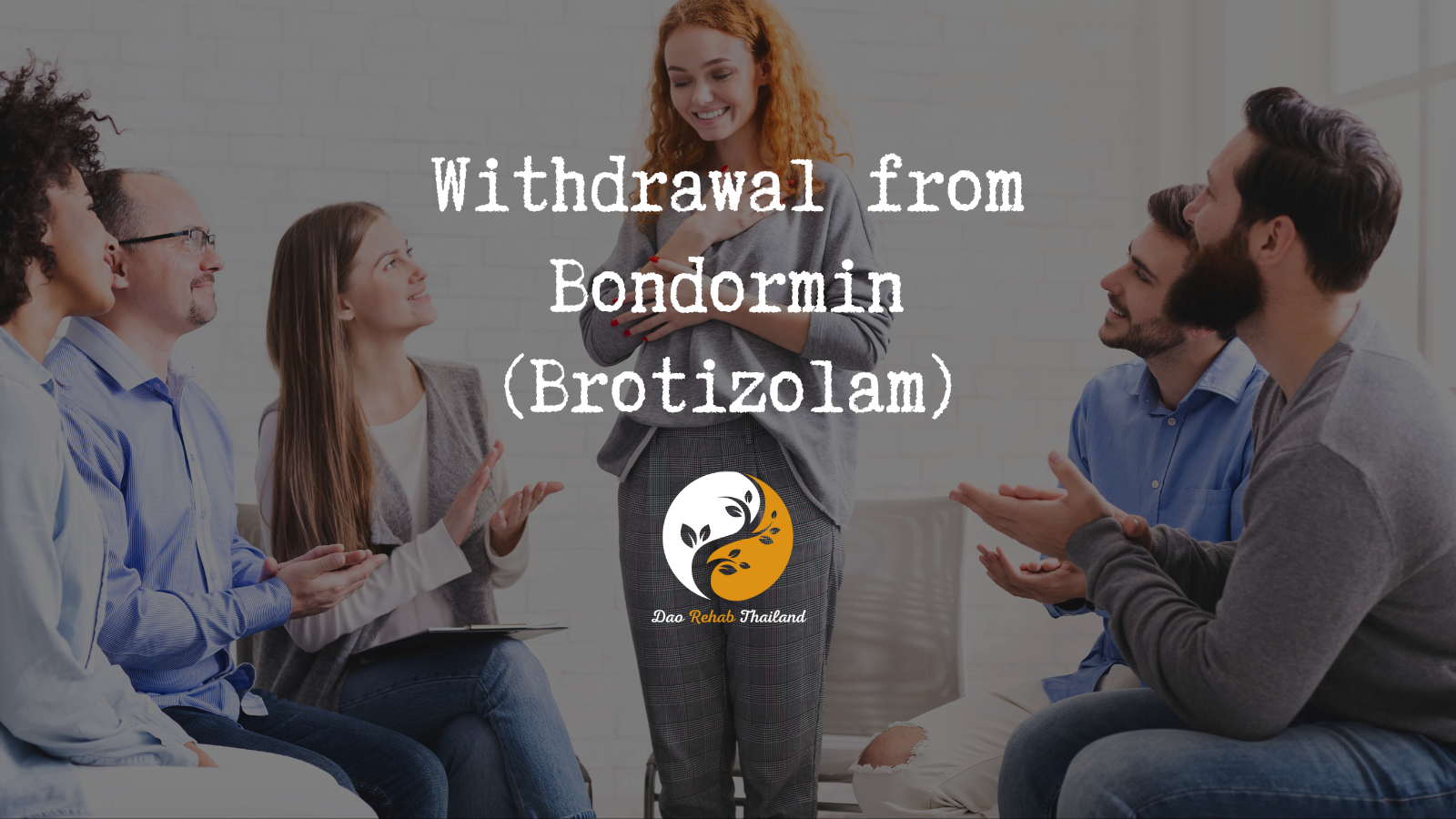
Withdrawal from Bondormin (Brotizolam)
Withdrawal from Bondormin
“Turning the impossible into possible”

"Detox from Drugs at a Luxury Holistic Center in Thailand and Israel"

Withdrawal from Bondormin (Brotizolam)
Bondormin, containing the active ingredient Brotizolam, is a benzodiazepine medication used for short-term treatment of sleep disorders such as insomnia. Prolonged or uncontrolled use can lead to physical and psychological dependence, and discontinuation may result in withdrawal symptoms.
"Holistic Center for Trauma, Addiction, and Mental Imbalance Treatment in Thailand"
“Come to the beginning of your journey to freedom from addiction to alcohol, drugs, and pills, and rediscover your life within the serene embrace of DaoTherapy Rehab in Thailand—where holistic healing meets empowering recovery.”
DaoTherapy Holistic Rehab
Key Elements of Drugs Detox:
Medical Supervision: Drugs detox must be conducted under medical supervision, as the body may experience withdrawal symptoms. These can include nausea, anxiety, muscle aches, and insomnia. A medical team will monitor and manage these symptoms to ensure the patient’s safety and comfort.
Holistic Therapies:
Holistic Therapies: Many detox programs incorporate holistic therapies such as mindfulness, yoga, and meditation to help individuals cope with stress and anxiety during the detox process. These therapies support the mind-body connection and contribute to overall recovery.
Tapering Process
Tapering Process: Drugs detox often involves a gradual tapering of the drug to reduce withdrawal severity. Doctors will slowly decrease the dosage over time to allow the body to adjust to lower levels of the substance.
Psychological Support:
Psychological Support: Like any addiction recovery process, detox from Drugs includes psychological support. This can involve counseling, therapy, or support groups to address the mental and emotional aspects of addiction.
Post-Detox Treatment:
Post-Detox Treatment: After completing detox, continuing treatment is crucial to prevent relapse. This often includes participation in ongoing therapy, group support, and the development of new coping strategies to maintain sobriety.
Withdrawal Symptoms from Bondormin:
Withdrawal Symptoms from Bondormin:
Physical Symptoms:
- Tremors.
- Excessive sweating.
- Muscle or joint pain.
- Nausea or vomiting.
- Rapid or irregular heartbeat.
Psychological Symptoms:
- Increased anxiety or panic attacks.
- Irritability and tension.
- Feelings of depression or hopelessness.
- Restlessness.
Neurological Symptoms:
- Severe insomnia.
- Hallucinations or vivid dreams.
- Heightened sensitivity to noise or light.
- In severe cases, seizures.
Factors Influencing Withdrawal:
- Duration of use: Long-term use increases the risk of severe withdrawal.
- Dosage: Higher doses exacerbate symptoms.
- Mental and physical health: Users with pre-existing mental health issues may experience more challenging withdrawal.
How to Undergo Withdrawal from Bondormin:
Gradual Tapering:
Abrupt cessation can be dangerous. Proper withdrawal involves gradually reducing the dosage, sometimes switching to a longer-acting benzodiazepine.Medical Supervision:
Withdrawal should be conducted under medical supervision to prevent complications such as seizures or severe depression.Emotional Support:
Psychological therapy or support groups can help address anxiety and depression during withdrawal.Complementary Methods:
- Meditation or yoga to reduce stress.
- Balanced nutrition and physical activity to support recovery.
Duration of Withdrawal Symptoms:
- Acute phase (days to a week): Significant physical and psychological symptoms.
- Subacute phase (weeks): Gradual reduction of psychological symptoms.
- Prolonged phase (months): Mild anxiety or depression may persist.
Warning:
Do not discontinue Bondormin without medical advice. Abrupt cessation can lead to life-threatening complications, especially if taken in high doses or for an extended period.

contact us
Contact us with your questions
We would love to speak with you! Feel free to reach out with any questions.

get in touch
Schedule a free consultation
Schedule a free consultation with our team and let’s make things happen!
General Background and History of Bondormin
Bondormin, with the active ingredient Brotizolam, is a medication from the benzodiazepine family. It is developed for short-term use in the treatment of sleep disorders, primarily insomnia. It works by acting on the central nervous system, helping individuals fall asleep faster and reducing the time it takes to initiate sleep.
History and Development
Development of Benzodiazepines (1960s):
Benzodiazepines were developed as a safer alternative to barbiturates, which had severe side effects and high addiction potential.
Brotizolam, the active ingredient in Bondormin, was introduced in the 1970s and 1980s, primarily to address sleep disorders.Approval of the Drug:
- Brotizolam was approved for use in various countries, including Europe and Israel, for short-term treatment only (up to two weeks) to avoid addiction risks.
- In the U.S., the drug was never approved due to concerns about side effects and dependency.
Effectiveness:
Bondormin is considered an effective sleep aid, differing from long-acting benzodiazepines.- Short half-life: The effects last only a few hours, making it suitable for treating insomnia without causing next-day drowsiness.
- Fast onset: The drug typically takes effect within 20-30 minutes.
Medical Use and Misuse
Medical Use:
The drug is prescribed in low doses, primarily for short-term sleep issues related to stress, temporary depression, or anxiety.Misuse:
Due to its calming and sleep-inducing effects, some users take the drug without medical supervision, leading to a high risk of psychological and physical dependence.Legal Restrictions:
In many countries, including Israel, the drug is classified as a controlled substance, and its distribution without a prescription is a serious offense.
Limitations and Side Effects
Usage Limits:
- Bondormin is intended for short-term use (up to two weeks) because prolonged use can lead to dependence, tolerance, and severe withdrawal symptoms.
Side Effects:
- Drowsiness and fatigue the next day.
- Impaired coordination or increased risk of falls (especially in the elderly).
- Mood changes, including anxiety, irritability, or depression.
Long-Term Effects
- Dependence: Long-term use can result in physiological and psychological dependence.
- Memory Impairment: Benzodiazepines may affect short-term memory.
- Withdrawal Symptoms: Abrupt discontinuation can cause severe symptoms such as anxiety, rebound insomnia, and even seizures.
The Importance of Medical Supervision
Bondormin can be very effective when taken as prescribed, but it requires careful monitoring due to its potential for addiction and severe side effects. Today, physicians often prefer alternative medications or non-pharmacological treatments to minimize dependency risks.
Withdrawal from Benzodiazepines Like Bondormin
Withdrawal from benzodiazepines, including Bondormin, is a challenging process that requires close medical supervision. Due to the risk of dependence and severe withdrawal symptoms, abrupt cessation of the drug should be avoided, especially after prolonged use or at high doses.
Why Is It Difficult to Quit Benzodiazepines?
Physical Dependence:
Benzodiazepines act on the central nervous system, calming the body and mind by reducing nerve activity. Over time, the body develops tolerance, requiring higher doses to achieve the same effect.Psychological Dependence:
Users may feel they “cannot function” without the drug, particularly if they suffer from anxiety, depression, or sleep disorders.
Common Withdrawal Symptoms
Physical Symptoms:
- Rapid heart rate.
- Body tremors.
- Excessive sweating.
- Nausea and vomiting.
- Severe fatigue or lack of energy.
Psychological Symptoms:
- Increased anxiety or panic attacks.
- Feelings of depression.
- Irritability and tension.
- Severe insomnia.
Neurological Symptoms:
- Heightened sensitivity to light and noise.
- “Brain fog.”
- In severe cases, seizures.
How Is Benzodiazepine Withdrawal Managed?
1. Gradual Tapering:
- What Does This Mean?
Instead of stopping the drug abruptly, the dosage is gradually reduced over weeks or months. - Why Is It Important?
Gradual tapering allows the nervous system to readjust without the drug and reduces the risk of severe symptoms.
2. Medical Supervision:
- Close medical monitoring is crucial to manage physical symptoms, such as rapid heart rate or seizures, which can be life-threatening.
3. Emotional Support:
- Psychological therapy can help address anxiety and depression during withdrawal.
- Support groups (e.g., 12 Steps) provide a safe space for sharing experiences and receiving emotional encouragement.
4. Substitution Therapy:
- A benzodiazepine with a longer half-life (e.g., diazepam) is often used to ease the withdrawal process.
Complementary Methods for Support:
- Meditation and Yoga:
Help with relaxation and stress reduction. - Exercise:
Boosts mood and promotes overall health. - Balanced Nutrition:
Supports physical recovery. - Relaxation Techniques:
Such as deep breathing and guided imagery, reduce anxiety.
Duration of the Withdrawal Process
- Acute Phase (Days to Weeks): Severe physical and psychological symptoms.
- Subacute Phase (Weeks to Months): Symptoms gradually lessen, but feelings of anxiety or fatigue may persist.
- Prolonged Phase (Months): Mild symptoms like irritability or insomnia may linger.
Warning:
Withdrawal from benzodiazepines without medical supervision can be extremely dangerous, especially due to the risk of seizures. If you or someone close needs help, consult a qualified healthcare provider.








